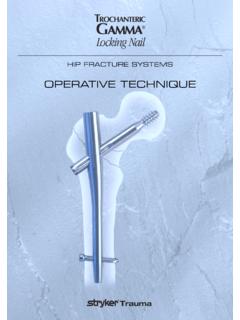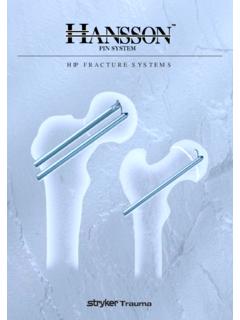Transcription of S2™ Tibial Nail - Stryker
1 Operative TechniqueTraumaS2 Tibial NailDr. George Anastopoulos, Dept. of Orthopaedics and TraumatologyGeneral Hospital G. Gennimatas Athens, GreeceProf. Kwok Sui Leung, of Orthopaedics and TraumatologyChinese University of Hong KongPrince of Wales Hospital, Hong KongDavid Seligson, and Vice Chairman of the Department of Orthopaedic SurgeryUniversity of LouisvilleLouisville, Kentucky USAAdam Starr, Professor Department of Orthopedic SurgeryUniversity of Texas - Southwestern Medical CenterDallas, Texas USADr. Gilbert Taglang,Chief Surgeon - Emergency DepartmentCenter of Traumatology and Orthopaedics, CTO - Strasbourg, FranceThis publication sets forth detailed recommended procedures for using Stryker Trauma devices and offers guidance that you should heed, but, as with any such technical guide, each surgeon must consider the particular needs of each patient and make appropriate adjustments when and as workshop training is required prior to first Surgeons :244 66 7 788889 9 10 10 1113 13 16 18192022 Contents31.
2 Implant Instrument References2. Indications3. Pre-operative Planning4. Operative Patient Positioning and Fracture Entry Unreamed Reamed nail Distal Targeting Device nail Insertion Distal Guided Locking Mode (via Distal Targeting Device) Proximal Guided Locking Mode (via Target Device) Freehand Distal Locking End Cap nail Removal Ordering Information - Implants Ordering Information - Instruments Introduction1. Introduction4 The S2 Nailing System represents the latest and most comprehensive development of the original intra-medullary principles presented by Prof. Gerhard K ntscher in Trauma has created a new generation locking nail system, brin-ging together all the capabilities and benefits of separate nailing systems to create a single, integrated surgical resource for fixation of long bone fractures (1).
3 The S2 Tibial nail offers the follo-wing competitive advantages: Accommodates reamed or unre-amed procedures. Provides solutions for very proxi-mal and very distal tibia fractures Distal Guided Locking option (via Distal Targeting Device)Through the development of a com-mon, streamlined and intuitive sur-gical approach, both in principle and in detail, the S2 Tibial nail offers significantly increased speed and functionality for the treatment of fractures as well as simplifying the training requirements for all person-nel S2 Tibial nail is the realization of superior biomechanical intrame-dullary stabilization using small cali-ber, strong, cannulated implants for internal fixation of the S2 Tibial nail may be used for very proximal and very distal fractu-res due to the two M/L proximal holes for static locking and 3 distal (M/L, A/P, M/L) locking.
4 The distal most hole is centered at 5mm from the tip of the nail to better address hard to reach distal 5mm cortical screws sim-plify the surgical procedure and pro-mote a minimally invasive approach. Fully Threaded Locking Screws are available for regular locking :The 8mm S2 Tibial nail can only be locked distally with 4mm Fully Threaded Screws. As with all dia-meters of the S2 Tibial Nails, 5mm Fully Threaded Screws are used for proximal Caps are available in various sizes to provide a best fit for every indi-cation and prevent bony or soft tissue ingrowth into the proximal threads of the nail . The End Cap will also tighten down on the most proximal locking Screw, thus avoiding lateral sliding of the the S2 Tibial nail implants are made of Stainless Steel (316 LVM).
5 The S2 Tibial Nails are cannulated, not slotted and have a fluted profile for an optimal bending addition, two longitudinal grooves (one on each side of the nail ), between the 2 M/L Distal Locking Holes, are designed for the Distal Guided Locking Mode technique (via S2 Distal Targeting Device). The main principle of this technique is based on easy nail detection with a Probe inserted into this groove. The groove is used to further guide the Probe into the Locking Hole. For detailed information about Distal Guided Locking Mode technique, please refer to the S2 Distal Targeting Device OP Technique, REF. NO. the detailed chart on the next page for design specifications and size Implant Fully Threaded Locking Screws for 8mm Nails (Distal Holes only)L = 25 60mmNote: Screw length is measured from the top of the head to the tipStandard+5mm+10mm+15mmS2 Tibial nail Diameter 8 14mmSizes 240 420mm (in 15mm increments) S2 End Caps S2 Locking Fully Threaded Locking Screws L = 25 120mm5mm19mm35mm10 Herzog Bend(at 50mm from driving end)25mm15mm 4 Distal Bend(at 60mm from the tip)
6 6 The major advantage of the instrument system is a break-through in the integration of the instrument platform which can be used not only for the complete S2 Nailing System, but will be the platform for future Stryker Trauma nailing systems, reducing complexity and instrument platform offers advanced precision and usability, and features ergonomically styled targeting addition to the advanced precision and usability, the instruments are number and color coded to indicate the step during the surgical procedure in which the instrument is feature color coded = GreenFor Fully Threaded Locking = OrangeFor 4,0mm Fully Threaded Locking Screws for the distal holes, only for the 8mm Tibial to the S2 Nailing System is a special Distal Targeting Device designed for Distal Guided Locking Technique.
7 The S2 Distal Targeting Device offers the competitive advantage of: Eliminating the need for fluorosco-pic guidance for the distal locking procedure Reducing the operative time Easy calibration for each individual S2 detailed information about the Distal Targeting Device please refer to the S2 Distal Targeting Device Operative Technique, REF. NO. M ller, et al., Manual of Internal Fixation, Springer Verlag, Goessens, R. Sijbers, Harbers, Stapert, Application of a proximal entry point for intra-medullary nailing of the tibia, Osteosinthese International (2001) 9: 101 104 FeaturesStep Color NumberOpening Red 1 Reduction Brown 2 nail Introduction Green 3 Guided Locking Light Blue 4 Freehand Locking Dark Blue Instrument References7 Fig. 1S2 Tibial NailScale:1,10 : 110 % :1806-8008/Rev.
8 :00 nail diametersNail lengthrangefor all diameters: 240- 420mm 8mm 14mm 12mm 11mm 10mm 9mm ntscher Str. 1-524232 Sch nkirchenGermany0102030405060708090100110 120LS2 Tibial NailLockingOptionsSt atic240mm255mm270mm285mm300mm330mm315mm3 45mm360mm375mm390mm405mm420mm+5 mm+10mm+15mmEnd caps 1 1,5mm 1 1,5mm 8 mm 10 mm 1 1 mm 12 mm 13 mm 14 mm 9 mm 12mm 13mm 14mmThe S2 Tibial nail is indicated for: Open or closed shaft fractures with a very proximal and/or very distal extent in which locking screw fixation can be obtained Multi-fragment fractures Segmental fractures Pathologic and impending pathologic fractures Tumor resections Corrective osteotomies/Mal-unions Non-unions Comminuted fractures with or without bone loss3. Pre-operative PlanningAn X-Ray Template, Tibia (1806-8008) is available for pre-operative planning (Fig.)
9 1).Thorough evaluation of pre-operative radiographs of the affected extremity is critical. Careful radiographic examination can prevent intra-operative standard mid-shaft fractures, the proper nail length should extend from just below the Tibial Plateau at the appropriate mediolateral position to just proximal to the Epiphyseal Scar of the ankle :Check with local representative regarding availability of nail Indications8 Operative Technique4. Operative Patient Positioning and Fracture Reductiona) The patient is placed in the supine position on a radiolucent fracture table and the leg is hyperflexed on the table with the aid of a leg holder, orb) The leg is free-draped and hung over the edge of the table (Fig. 2).The knee is flexed to >90 . A triangle may be used under the knee to accommodate flexion intra-opera-tively.
10 It is important that the knee rest is placed under the posterior aspect of the lower thigh in order to reduce the potential of vascular compression and the risk of pushing the proximal frag-ment of the tibia reduction can be achieved by internal or external rotation of the fracture and by traction, adduction or abduction, and must be confirmed under image intensification. Draping must leave the knee and the distal end of the leg IncisionA para-tendenous incision is made from the patella extending down approximately 4cm in preparation of nail insertion. The Patellar Tendon may be retracted laterally or split at the junction of the medial third, and late-ral two-thirds of the Patellar Ligament. This exposes the entry point (Fig. 3).Fig. 5 Fig. 6 Fig. 2 Fig. 3 Fig. Entry PointBased on radiological image, the medullary canal is opened through a superolateral plateau entry portal (2).









